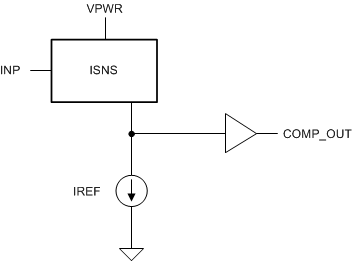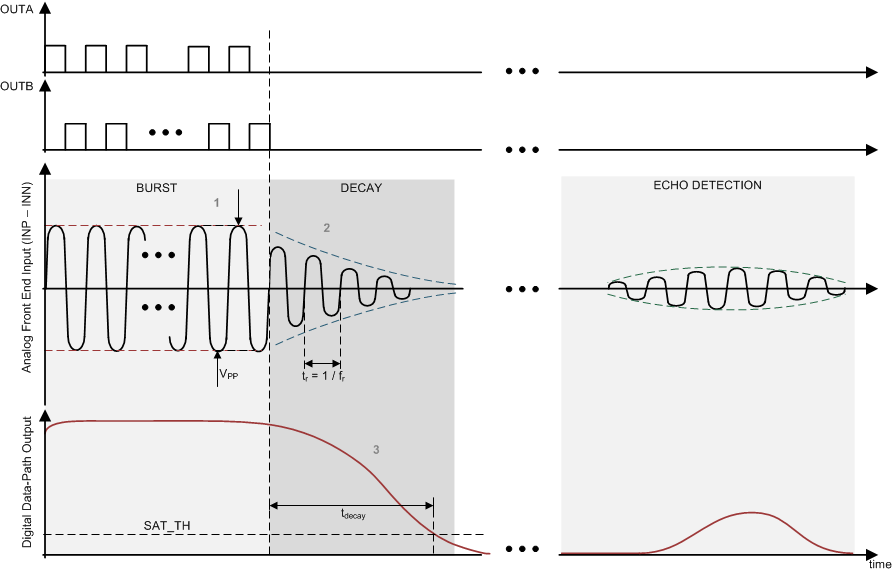SLASEJ4C April 2017 – February 2023 PGA460
PRODUCTION DATA
- 1 Features
- 2 Applications
- 3 Description
- 4 Revision History
- 5 Pin Configuration and Functions
-
6 Specifications
- 6.1 Absolute Maximum Ratings
- 6.2 ESD Ratings
- 6.3 Recommended Operating Conditions
- 6.4 Thermal Information
- 6.5 Internal Supply Regulators Characteristics
- 6.6 Transducer Driver Characteristics
- 6.7 Transducer Receiver Characteristics
- 6.8 Analog to Digital Converter Characteristics
- 6.9 Digital Signal Processing Characteristics
- 6.10 Temperature Sensor Characteristics
- 6.11 High-Voltage I/O Characteristics
- 6.12 Digital I/O Characteristics
- 6.13 EEPROM Characteristics
- 6.14 Timing Requirements
- 6.15 Switching Characteristics
- 6.16 Typical Characteristics
-
7 Detailed Description
- 7.1 Overview
- 7.2 Functional Block Diagram
- 7.3
Feature Description
- 7.3.1 Power-Supply Block
- 7.3.2 Burst Generation
- 7.3.3 Analog Front-End
- 7.3.4 Digital Signal Processing
- 7.3.5 System Diagnostics
- 7.3.6
Interface Description
- 7.3.6.1 Time-Command Interface
- 7.3.6.2
USART Interface
- 7.3.6.2.1 USART Asynchronous Mode
- 7.3.6.2.2 One-Wire UART Interface
- 7.3.6.2.3 Ultrasonic Object Detection Through UART Operations
- 7.3.6.3 In-System IO-Pin Interface Selection
- 7.3.7 Echo Data Dump
- 7.3.8 Low-Power Mode
- 7.3.9 Transducer Time and Temperature Decoupling
- 7.3.10 Memory CRC Calculation
- 7.3.11 Temperature Sensor and Temperature Data-Path
- 7.3.12 TEST Pin Functionality
- 7.4 Device Functional Modes
- 7.5 Programming
- 7.6 Register Maps
- 8 Application and Implementation
- 9 Device and Documentation Support
- 10Mechanical, Packaging, and Orderable Information
Package Options
Mechanical Data (Package|Pins)
- PW|16
Thermal pad, mechanical data (Package|Pins)
Orderable Information
7.3.5 System Diagnostics
The system diagnostics in the PGA460 device help characterize the transducer element during the burst itself and determine the status of the overall system. By using the provided information the system should be able to detect transducer failure, driver-circuit failure (transformer failure if used), environmental effects on the system (such as ice, dirt, snow), objects compromising the transducer operation (such as pressure applied to the transducer), and others.
Three implemented system diagnostics are available in the PGA460 device that provide information which can be used in detecting system flaws. These diagnostics are described as follows:
- Voltage diagnostic measurementThe voltage diagnostic feature is obtained by monitoring the current flowing through the INP pin
only when a BURST/LISTEN run command is executed. The transducer excitation
voltage at the particular burst frequency results in a current at INP pin
that is compared to a reference current with a current comparator as shown
in #T4490914-17. If the excitation current exceeds the threshold level set using the
FVOLT_ERR_TH in FVOLT_DEC register, the current comparator output goes high
which implies a normal burst with the desired level of excitation voltage.
The measurement starts approximately 50 µs after the burst stage is started
and ends at the end of the burst stage. The result of this diagnostic
measurement is reported in the status frames of the IO time-command or the
UART interface as described in the GUID-FCDC9FE7-D63B-43FC-8447-FE69FA9311C2.html#TITLE-SLASEC8X4608 section.
- FVOLT_ERR_TH[2:0] corresponds to 1 for 000b to 8 for 111b.
- f(burst) is the burst frequency in kilohertz.
- C(INP) is the input capacitance on the INP pin.
- R(INP) is an optional resistor (see GUID-B9FF5C83-FADD-4C3D-9B75-778EE332DC63.html#X3519) used for EMI and ESD robustness.
 Figure 7-8 Block Diagram for Voltage Diagnostic
Figure 7-8 Block Diagram for Voltage Diagnostic
where
Prior to bursting, the comparator output is expected to be low. In the event that the output is stuck high, the condition is detected and the diagnostic fail flag is set
- Transducer frequency measurementDuring the decay stage of the record interval a frequency measurement on the transducer node is performed to validate the performance and proper tuning of the transformer and transducer matching.
- Assume FDIAG_START = 2 and FDIAG_LEN = 1. Referring to the GUID-ED773D30-2D5D-4A9D-B0E9-278B351A9705.html#TITLE-SLASEC8X3442 section, the start time of these EEPROM parameters is determined to be 200 µs after the burst is completed and window length of 3 signal periods. Assuming an operating frequency of 58 kHz, the signal period is 17.24 µs and therefore the diagnostic ends at 200 µs + 3 × 17.24 µs = 251.72 µs after the burst is complete.
- The frequency information captured in the measurement window is averaged and
expressed as a 500-ns time based counter value.
The signal frequency can be calculated using #T4793009-1. Equation 5. f = 1 / (FDIAG_VAL × 500e–09)
where
- FDIAG_VAL is a value that can be extracted using any of the device interfaces.
- If the specified number of objects are detected before a frequency diagnostic measurement completes, no frequency measurement results are saved. This can be managed by setting the previously defined diagnostic parameters and threshold settings for near-object detection.
To measure the transducer frequency, a start parameter, FDIAG_START, and a window length parameter, FDIAG_LEN, are defined in EEPROM memory. The start parameter, FDIAG_START, defines the time when the frequency measurement starts relative to the end of the burst time. The diagnostic window length parameter, FDIAG_LEN, sets the time width of the diagnostic window in terms of signal periods captured. A brief example of parameter configuration can be explained:
An additional frequency error feature is implemented in the PGA460 device to signify that the measured transducer frequency is outside of the limits set by the FDIAG_ERR_TH threshold parameter. The result of this feature is reported in the status frames of the IO time-command or the UART interface. For more information on reporting the transducer frequency error, see the GUID-FCDC9FE7-D63B-43FC-8447-FE69FA9311C2.html#TITLE-SLASEC8X4608 section.
- Decay-period time captureDuring the decay stage of the record interval a transducer decay time measurement is performed to verify correct operation of the transducer. This diagnostic in combination with the transducer frequency measurement are commonly used in ultrasonic systems to detect external blockage of the ultrasonic transducer.
The decay period time is measured at the output of the digital data path. The measurement starts at the same time when the burst stage is completed and the decay period is measured as long as the echo level is higher than a saturation threshold level defined in the EEPROM by the SAT_TH parameter. The provided result can be extracted by using any of the PGA460 interfaces, while the value is expressed in 16-µs time increments. If the decay time measured greater than 4 ms, the value extracted will read 0xFF.
- Noise level measurementAn additional system diagnostic implemented in the PGA460 device is the noise-level measurement diagnostic. The purpose of this function is to evaluate the surrounding noise generated by other ultrasonic systems nearby to determine disturbances and also evaluate the noise floor level when far distance objects are being detected.
During the noise-level measurement, the PGA460 device executes the LISTEN ONLY (Preset2) command (see the GUID-FCDC9FE7-D63B-43FC-8447-FE69FA9311C2.html#TITLE-SLASEC8X4608 section for details of the command) where no burst is performed but only a record interval is started and lasts 8.192 ms. During this record interval, the data collected at the output of the digital data path is averaged into two groups each containing 4096 samples. The final noise level is measured by performing the noise-level measurement function is the higher averaged value of the two groups. This value is reported as the final noise-level measurement.
The nonlinear scaling block is always disabled (scale factor EEPROM by setting the SCALE_K bit 0 and the NOISE_LVL bit to 0) during the noise-level measurement process.
#X6721 shows the system diagnostics implemented in the PGA460 device as a full object-detection record cycle example. The numbers 1, 2, and 3 in #X6721 show voltage diagnostic, transducer frequency, and decay-period measurement, respectively.
 Figure 7-9 Systems Diagnostics Example
Figure 7-9 Systems Diagnostics Example